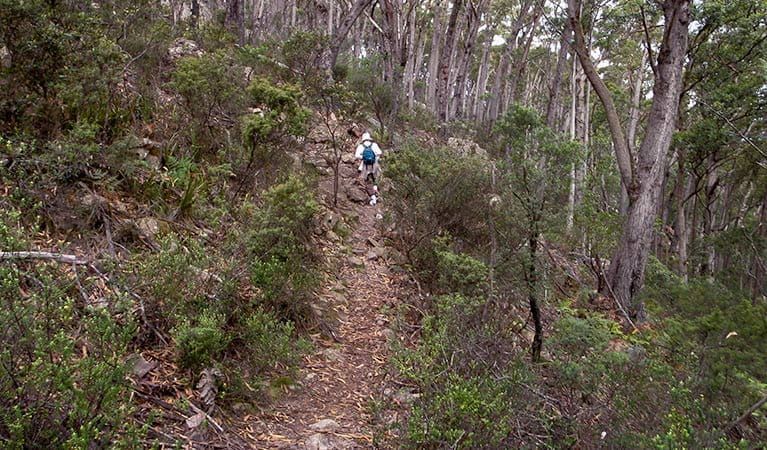Mount Imlay – Balawan Summit walking track
Mount Imlay National Park
Overview
This challenging walking track climbs over 600m from Burrawang picnic area to the summit of Mount Imlay – Balawan. Enjoy a picnic with a view, spring wildflowers and birdwatching.
- Where
- Mount Imlay National Park in South Coast
- Distance
- 6km return
- Time suggested
- 2 - 4hrs
- Grade
- Grade 5
- Trip Intention Form
-
It's a good idea to let someone know where you're going. Fill in a trip intention form to send important details about your trip to your emergency contact.
- What to
bring - Hat, sunscreen
- Please note
- Please clean your boots using the hygiene cleaning stations along Mount Imlay Summit walking track.
- The weather in this area can be extreme and unpredictable, so please ensure you’re well-prepared for your visit.
Starting at Burrawang picnic area, this challenging walk takes you through dry eucalypt forests and grassy woodlands to the summit of Mount Imlay. The track climbs steeply, rising 600m, but there’s plenty to distract you from the effort along the way.
In spring, stop to admire the delicate beauty and bright colours of wildflowers like mountain speedwell. Once you reach the summit, enjoy a rest and take in the views to the coast while you enjoy your picnic lunch. On a clear day, you can see all the way to Mallacoota in Victoria, and Narooma to the north.
It’s also a great spot for birdwatching. Watch for yellow-tailed black cockatoos flying overhead and listen closely for lyrebirds as you’re walking up the mountain.
Map
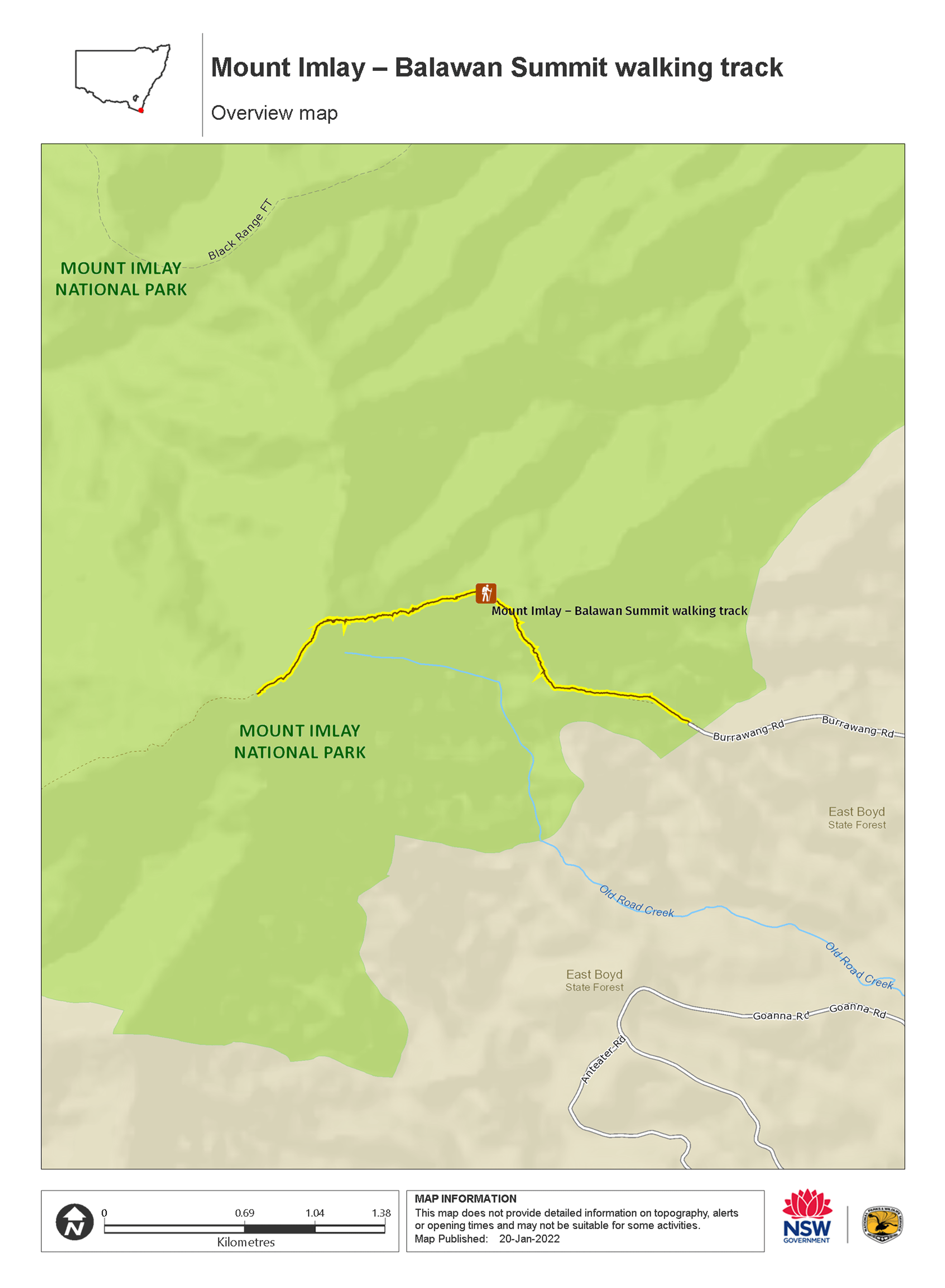
Map legend

Local alerts
For the latest updates on fires, closures and other alerts in this area, see https://www.nationalparks.nsw.gov.au/things-to-do/walking-tracks/mount-imlay-balawan-summit-walking-track/local-alerts
General enquiries
- National Parks Contact Centre
- 7am to 7pm daily
- 1300 072 757 (13000 PARKS) for the cost of a local call within Australia excluding mobiles
- parks.info@environment.nsw.gov.au
Park info
- in Mount Imlay National Park in the South Coast region
Mount Imlay National Park is always open but may have to close at times due to poor weather or fire danger.
Visitor info
All the practical information you need to know about Mount Imlay – Balawan Summit walking track.
Track grading
Features of this track
Distance
6km return
Time
2 - 4hrs
Quality of markings
Sign posted
Experience required
Experienced bushwalkers
Gradient
Very steep and difficult
Steps
Occasional steps
Quality of path
Rough track, many obstacles
Getting there and parking
Get driving directions
On entering Mount Imlay National Park:
- Continue driving through East Boyd State Forest until you reach Mount Imlay carpark and Burrawang picnic area.
Road quality
Check the weather before you set out as the road to Mount Imlay National Park can become slippery when it rains.
Parking
Parking is available at Mount Imlay Summit walking track.
Best times to visit
There are lots of great things waiting for you in Mount Imlay National Park. Here are some of the highlights.
Autumn
Take advantage of the cooler weather and spend the day walking on Mount Imlay Summit walking track.
Spring
Admire the delicate beauty and bright colours of wildflowers, like mountain speedwell, dotted among boulders and throughout the bush.
Summer
Head to Burrawang picnic area for a relaxing afternoon picnicking under the trees.
Winter
Enjoy the filtered views to the coast from the summit of Mount Imlay on crystal clear winter days.
Weather, temperature and rainfall
Summer temperature
Average
14°C and 22°C
Highest recorded
37.2°C
Winter temperature
Average
8°C and 15°C
Lowest recorded
2°C
Rainfall
Wettest month
January
Driest month
August
The area’s highest recorded rainfall in one day
456.5mm
Facilities
Drinking water is not available in this area, so it’s a good idea to bring your own.
Maps and downloads
Prohibited
Pets
Pets and domestic animals (other than certified assistance animals) are not permitted. Find out which regional parks allow dog walking and see the pets in parks policy for more information.
Smoking
NSW national parks are no smoking areas.
Learn more
Mount Imlay – Balawan Summit walking track is in Mount Imlay National Park. Here are just some of the reasons why this park is special:
Aboriginal cultural heritage
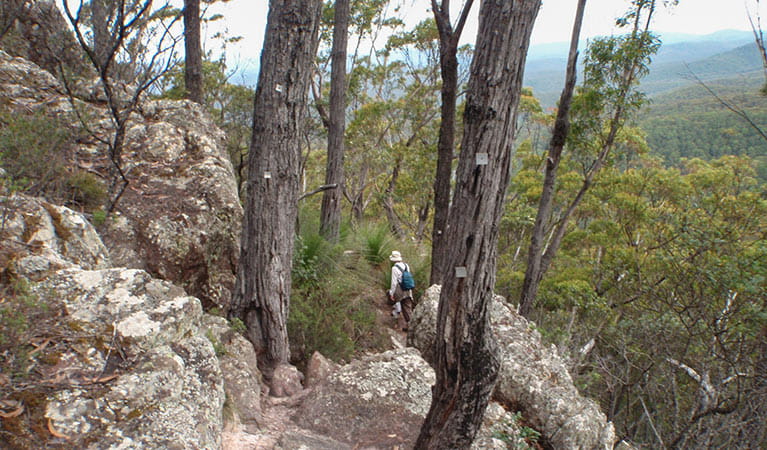
Mount Imlay is known to local Aboriginal people as 'Balawan', and is a place of great spiritual significance. The mountain, surrounding gullies, forest and animals that make their home here are important to local Aboriginal culture and spiritual teachings.
Band of brothers
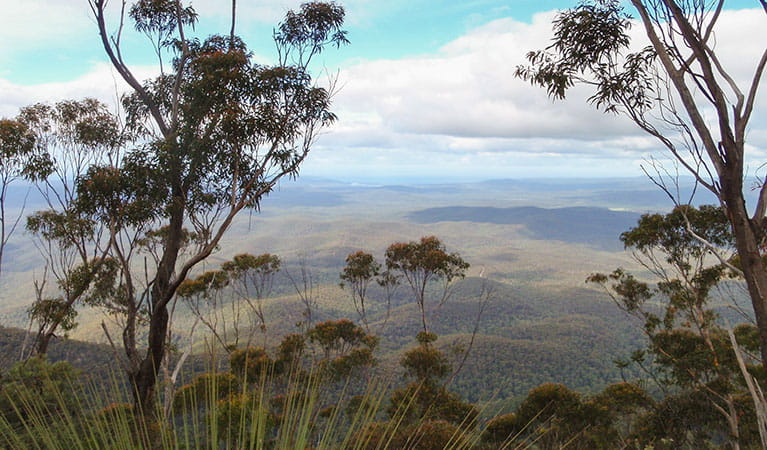
Mount Imlay is named after the three Imlay brothers, who played an important part in opening the Eden-Monaro district to European settlement in the 1830s and 40s. Alexander, Peter and George Imlay arrived in Australia from Scotland in 1829, 1830 and 1833 respectively. Within a few years, they had established whaling, pastoral and trading enterprises near Twofold Bay at Eden and on the Monaro plains.
Exquisite growth and hidden wildlife
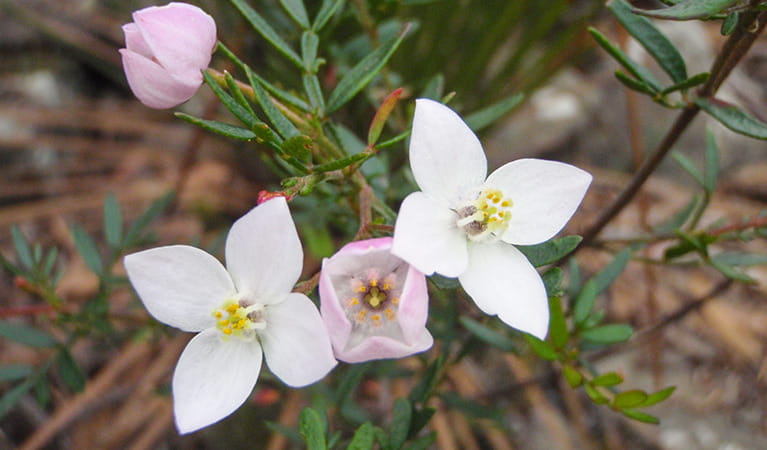
Many of the animals that make Mount Imlay their home are nocturnal, like the eastern pygmy-possum. But during the day, you could see red-necked wallabies, swamp wallabies, wombats and bush rats. If you're really lucky, you might even spot threatened species like the long-nosed potoroo, koala or the tiger quoll. Mount Imlay is a fantastic place for birdwatching, and you'll find a variety of birds like honeyeaters, currawongs and tree-creepers. As you wander through the forest, keep your ears and eyes out for lyrebirds fossicking in the understorey. And with a bit of luck, you might spot threatened species like the olive whistler, sooty owl and glossy black cockatoo. Mount Imlay is a botanical treasure of the far south east, where you'll find a number of threatened or biogeographically significant plant species, including the extremely rare Mount Imlay mallee and endangered Mount Imlay boronia. The bushland here also supports many native wildflowers, which come to life in spring and colour the bushland with purple, pink, yellow, white and red flowers.
- Mount Imlay – Balawan Summit walking track This challenging walking track climbs over 600m from Burrawang picnic area to the summit of Mount Imlay – Balawan. Enjoy a picnic with a view, spring wildflowers and birdwatching.

